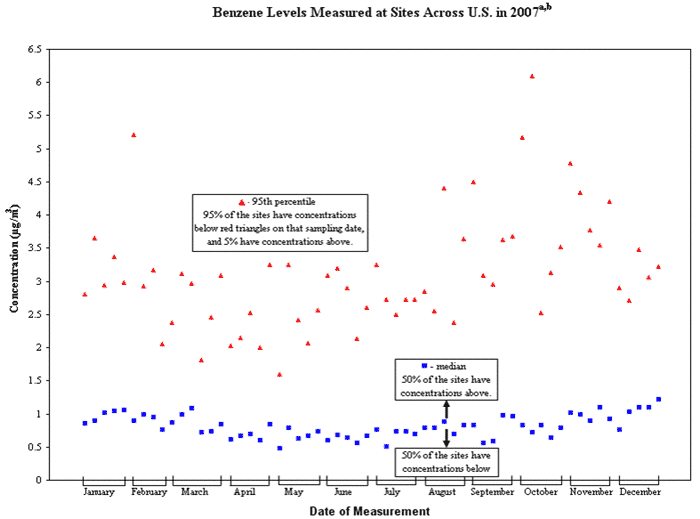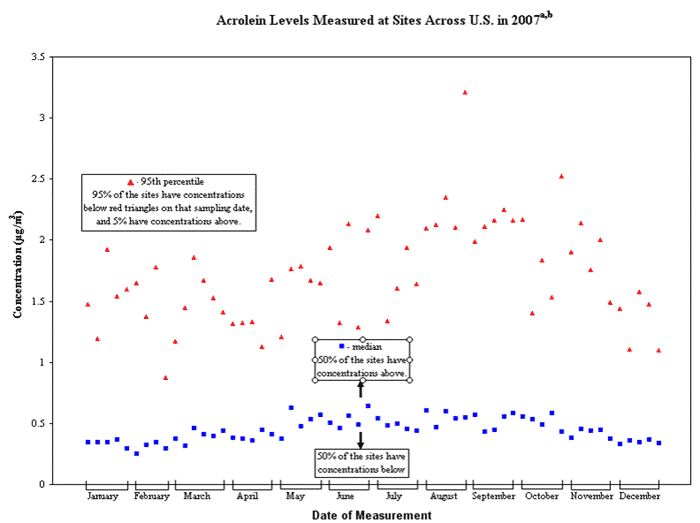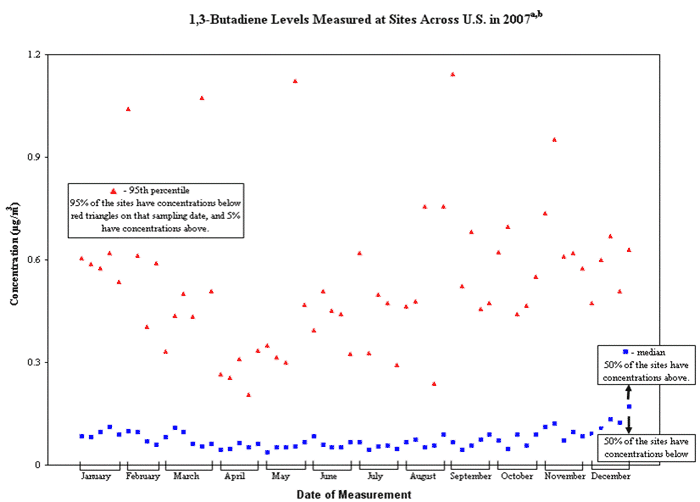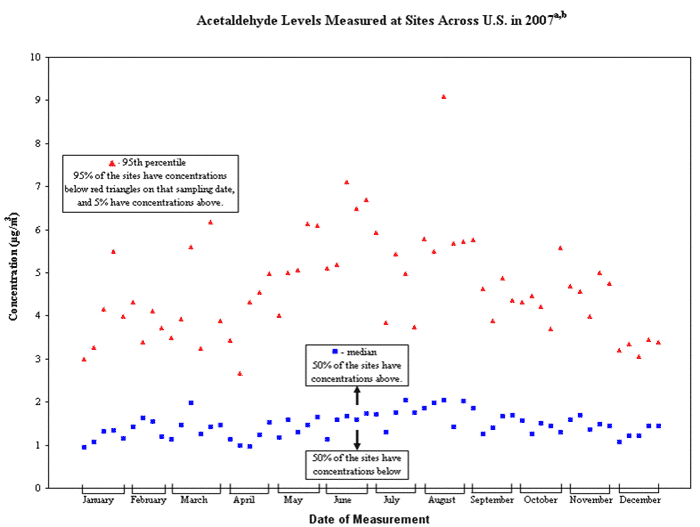Assessing Outdoor Air Near Schools
Mobile Sources
Key National Air Toxics
There are several air toxics that EPA recognizes as key pollutants nationally. This group of pollutants includes benzene and acrolein, because EPA’s national-scale air toxic assessments have repeatedly identified them as significant national risk “drivers.” They are considered risk drivers because a large number of people live in areas across the U.S. with elevated ambient concentrations of these pollutants. This indicates a potential for elevated health risk. EPA has also identified a number of other pollutants, including 1,3-butadiene and acetaldehyde, as regional drivers or national contributors to potential risk.
Although the sources of these pollutants may vary between locations, mobile sources (motor vehicles and nonroad equipment like bulldozers, lawn mowers and farm equipment) contribute significantly to emissions of benzene, acrolein, 1,3-butadiene, and acetaldehyde nationwide. These mobile source air toxics may be a particular concern for schools near heavily travelled roadways.
Diesel exhaust is also one of the mobile source air toxics of greatest concern. Diesel exhaust cannot be measured directly and is not a focus of the monitoring at schools, although some local agencies are monitoring components for this pollutant, such as black carbon.
Strategies to Reduce Mobile Source Pollution
EPA has taken aggressive action to reduce emissions of mobile source air toxics, including the key pollutants mentioned above, and continues to take additional action. Programs to reduce mobile source air toxics include motor vehicle and nonroad engine emissions standards, fuel controls, and motor vehicle inspection and maintenance programs. While some programs, such as the 2007 mobile source air toxics rule, target toxic air emissions specifically, other emission standards were put in place primarily to reduce outdoor levels of ground-level ozone and particulate matter through volatile organic compound (VOC) and diesel PM controls, which reduce air toxics as well. As a result of programs currently in place, EPA projects that mobile source air toxic emissions, including benzene, will decrease by about 60% between 1999 and 2020. EPA expects reductions of over 90% in emissions of diesel particulate matter from motor vehicles.
Recent national regulatory actions include:
- Integrated Approaches to Controlling Mobile Source Emissions
- Regulations controlling vehicles, engines and various equipment that relies on gasoline or diesel fuels
- Regulations controlling fuel properties
In addition to national regulations, there are actions that local agencies and communities can take to reduce elevated concentrations of air toxics, including these key pollutants, at locations near heavily travelled roadways. Recent research by EPA and others suggests that air pollution impacts near roads may be lower near road with mature nearby vegetation. Planting sufficiently tall and thick vegetation can promote dispersion of air pollution and reduce concentrations downwind of the road. Research also suggests that depressed roadways with vertical or sloped walls can reduce pollution concentrations downwind. Finally, upgrading air filtration systems in buildings may reduce concentrations of pollutants from outdoor sources to the indoor environment. EPA is conducting a large scale research program to characterize near-road pollution and improve mitigation strategies. More information on this research program can be found at the following links:
Information on air filtration systems for homes, schools, and large buildings can be found at:
- https://www.epa.gov/iaq/pubs/airclean.html
- https://www.epa.gov/iaq/schooldesign/hvac.html
- https://www.epa.gov/iaq/largebldgs/baqtoc.html
In addition to the strategies discussed above to reduce near roadway pollution, there are many other opportunties for states, local agencies and communities to improve air quality. More information on these opportunties can be found at the following link:
Reducing emissions from diesel engines is one of the most important air quality challenges facing the country today. EPA established the National Clean Diesel Campaign (NCDC) to promote diesel emission reduction strategies. NCDC includes regulatory programs to address new diesel engines as well as innovative programs to address the millions of diesel engines already in use. Through the regulatory component of the program, EPA has established new clean fuel and vehicle emission standards that will lead to dramatic emission reductions in new diesel-powered engines. However, More than 11 million diesel engines in operation today do not meet EPA’s new clean diesel standards, yet these engines can continue to operate for 20 to 30 years. EPA established innovative programs to accelerate emission reductions from older diesel engines to provide more immediate air quality benefits. The goal of these innovative programs is to address in-use diesel engines by promoting a variety of cost-effective emission reduction strategies, including: switching to cleaner fuels; retrofitting, repairing, repowering, and replacing equipment; and reducing idling. EPA has made significant progress toward this goal by engaging in partnerships, fostering innovative technologies, and providing funding assistance to accelerate the introduction of clean diesel technologies
One of the significant contributors to vehicle pollution near schools can be school buses. EPA’s Clean School Bus U. S. A. program is designed to help reduce pollution from buses by replacing the oldest, most polluting buses with new, cleaner models, and upgrading those that remain in the fleet.
EPA also provides information on other voluntary programs and other actions that you can take in your community to reduce air toxics from mobile sources.
Background Information on Key National Air Toxics
Benzene is a widely used chemical in the United States. Benzene is emitted to the air when coal and oil are burned. It also is found in motor vehicle and nonroad equipment exhaust and evaporative emissions, petroleum refining emissions, evaporative emissions from storage and transport of gasoline, and from industrial solvent emissions. Tobacco smoke also contains benzene and accounts for a large portion of the national exposure to benzene. Exposure to benzene increases the lifetime risk of leukemia and other blood disorders. Estimates from EPA’s national-scale air toxics assessments as well as from monitoring data collected nationally (which do not include exposures from tobacco smoke) indicate commonly occurring ambient concentrations of benzene that, if exposed to continuously over a lifetime, may have the potential to pose an increased cancer risk of greater than 10 in a million. Monitored levels of benzene have declined by 55 percent from 1994 to 2006, and will continue to decline as mobile source air toxics emission controls take effect.

a: On any given day, 191 to 237 monitors are represented.
b: Source: Phase VI Air Toxics Data Archive, U.S. EPA
This figure shows average benzene measurements from monitoring sites across the US. Although these measurements vary from day to day, this graph provides a sense of the typical range of levels observed at sites nationally. These monitors are in a variety of locations ranging from high traffic areas to more rural locations.
More information on benzene is available at: http://www.atsdr.cdc.gov/tfacts3.html
Acrolein can enter the air when organic matter such as trees and other vegetation is burned and also when fuels such as gasoline and oil are burned. It is also found in emissions from some industries. It can also be produced in the air from the breakdown of other chemicals and is a component of cigarette smoke. For many individuals, the primary exposure to airborne acrolein is from smoking tobacco or being near someone who is smoking. People may also be exposed to high acrolein levels from vehicle exhaust, such as in parking garages and/or areas of heavy traffic. House fires or forest fires also create situations with elevated acrolein levels. At high levels, exposed individuals may experience respiratory effects such as irritation of eyes, nose and throat. Individuals with emphysema or allergic conditions such as asthma may be at higher risk of respiratory effects than the general population. Estimates from EPA’s national-scale air toxics assessments and monitoring data collected nationally indicate that acrolein may be present in many areas of the U.S. above the long-term exposure level that EPA considers to pose little health risk. This level is a screening tool to help public health professionals decide where to look more closely. The local pattern of acrolein levels in these areas and the extent to which they might pose a risk of respiratory effects in exposed individuals depend on additional information including the activity of contributing sources (e.g., wildfires and heavy traffic) and other local conditions, as well as more specific information about acrolein and its health effects.

a: On any given day, 63 to 91 monitors are represented.
b: Source: Phase VI Air Toxics Data Archive, U.S. EPA
This figure shows average acrolein measurements from monitoring sites across the US. Although these measurements vary from day to day, this graph provides a sense of the typical range of levels observed at sites nationally.
More information on acrolein is available at: http://www.atsdr.cdc.gov/tfacts124.html
1,3-Butadiene enters the air in motor vehicle exhaust as well as in emissions from some industries. Although it breaks down quickly in the atmosphere, it is usually found in ambient air in urban and suburban areas at low levels. Short exposures to high levels of 1,3-butadiene in the air can cause irritation of the eyes, nose, throat and lungs. Studies of workers in plants that make rubber have shown a link between 1,3-butadiene exposure and increased risk of leukemia. EPA has concluded that 1,3-butadiene causes cancer in humans. Estimates from EPA’s national-scale air toxics assessments indicate ambient concentrations of 1,2-butadiene in some regions that, if exposed to continuously over a lifetime, may have the potential to pose an increased cancer risk of greater than 10 in a million.

a: On any given day, 129 to 174 monitors are represented.
b: Source: Phase VI Air Toxics Data Archive, U.S. EPA
This figure shows average 1,3-butadiene measurements from monitoring sites across the US. Although these measurements vary from day to day, this graph provides a sense of the typical range of levels observed at sites nationally.
Acetaldehyde enters the air in motor vehicle exhaust as well as in emissions from some industries, and from burning of organic matter such as trees and other vegetation. EPA has concluded that acetaldehyde probably causes cancer in humans. Exposure to high concentrations of acetaldehyde can also cause irritation of the eyes, skin, and respiratory tract. Estimates from EPA’s national-scale air toxics assessments indicate ambient concentrations of 1,2-acetaldehyde in some regions that, if exposed to continuously over a lifetime, may have the potential to pose an increased cancer risk of greater than 1 in a million.

a: On any given day, 89 to 133 monitors are represented.
b: Source: Phase VI Air Toxics Data Archive, U.S. EPA
This figure shows average acetaldehyde measurements from monitoring sites across the US. Although these measurements vary from day to day, this graph provides a sense of the typical range of levels observed at sites nationally.
You will need Adobe Acrobat Reader to view the Adobe PDF files on this page. See EPA's PDF page for more information about getting and using the free Acrobat Reader.
More on historically monitored air toxic trends nationally are available at:
- Trends in Toxic Air Pollutant Concentrations (PDF) (4pp, 710k)
- National Scale Air Toxics Assessments
